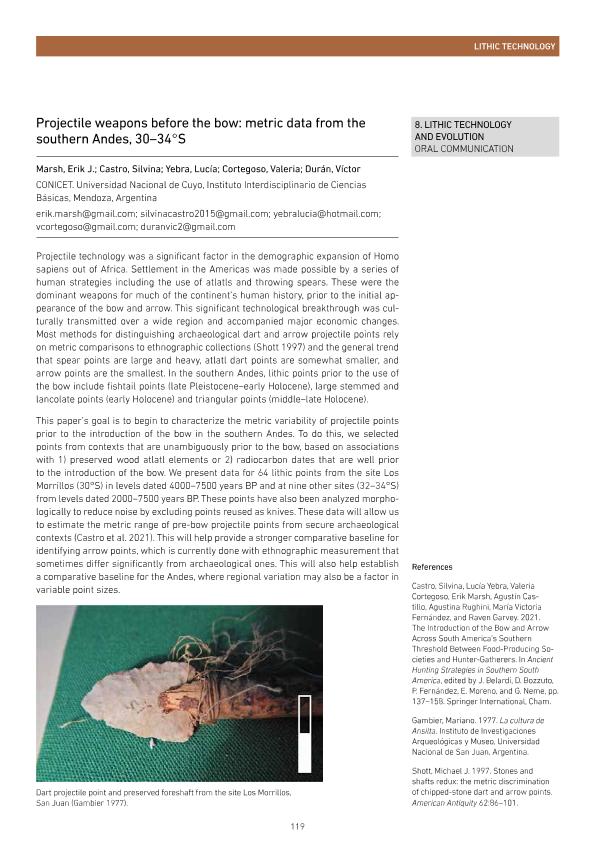Mostrar el registro sencillo del ítem
dc.contributor.author
Marsh, Erik Johnson

dc.contributor.author
Castro, Silvina Celeste

dc.contributor.author
Yebra, Lucía Gabriela

dc.contributor.author
Cortegoso, Valeria

dc.contributor.author
Duran, Victor Alberto

dc.date.available
2023-07-19T13:34:44Z
dc.date.issued
2021
dc.identifier.citation
Projectile weapons before the bow: metric data from the southern Andes; 13th International Symposium on Knappable Materials: Multi-scalar Characterization of Raw Materials; Tarragona; España; 2021; 119-119
dc.identifier.isbn
978-84-09-33737-8
dc.identifier.uri
http://hdl.handle.net/11336/204446
dc.description.abstract
Projectile technology was a significant factor in the demographic expansion of Homo sapiens out of Africa. Settlement in the Americas was made possible by a series of human strategies including the use of atlatls and throwing spears. These were the dominant weapons for much of the continent’s human history, prior to the initial appearance of the bow and arrow. This significant technological breakthrough was culturally transmitted over a wide region and accompanied major economic changes. Most methods for distinguishing archaeological dart and arrow projectile points rely on metric comparisons to ethnographic collections (Shott 1997) and the general trend that spear points are large and heavy, atlatl dart points are somewhat smaller, and arrow points are the smallest. In the southern Andes, lithic points prior to the use of the bow include fishtail points (late Pleistocene–early Holocene), large stemmed and lancolate points (early Holocene) and triangular points (middle–late Holocene). This paper’s goal is to begin to characterize the metric variability of projectile points prior to the introduction of the bow in the southern Andes. To do this, we selected points from contexts that are unambiguously prior to the bow, based on associations with 1) preserved wood atlatl elements or 2) radiocarbon dates that are well prior to the introduction of the bow. We present data for 64 lithic points from the site Los Morrillos (30°S) in levels dated 4000–7500 years BP and at nine other sites (32–34°S) from levels dated 2000–7500 years BP. These points have also been analyzed morphologically to reduce noise by excluding points reused as knives. These data will allow us to estimate the metric range of pre-bow projectile points from secure archaeological contexts (Castro et al. 2021). This will help provide a stronger comparative baseline for identifying arrow points, which is currently done with ethnographic measurement that sometimes di!er significantly from archaeological ones. This will also help establish a comparative baseline for the Andes, where regional variation may also be a factor in variable point sizes.
dc.format
application/pdf
dc.language.iso
eng
dc.publisher
Sid
dc.rights
info:eu-repo/semantics/openAccess
dc.rights.uri
https://creativecommons.org/licenses/by-nc-sa/2.5/ar/
dc.subject
Projectile weapons
dc.subject
Bow and arrow
dc.subject
Metric analysis
dc.subject
Spearthrowers
dc.subject.classification
Arqueología

dc.subject.classification
Historia y Arqueología

dc.subject.classification
HUMANIDADES

dc.title
Projectile weapons before the bow: metric data from the southern Andes
dc.type
info:eu-repo/semantics/publishedVersion
dc.type
info:eu-repo/semantics/conferenceObject
dc.type
info:ar-repo/semantics/documento de conferencia
dc.date.updated
2023-02-28T17:50:20Z
dc.journal.pagination
119-119
dc.journal.pais
España

dc.journal.ciudad
Tarragona
dc.description.fil
Fil: Marsh, Erik Johnson. Consejo Nacional de Investigaciones Científicas y Técnicas. Centro Científico Tecnológico Conicet - Mendoza. Instituto Interdisciplinario de Ciencias Básicas. - Universidad Nacional de Cuyo. Instituto Interdisciplinario de Ciencias Básicas; Argentina. Universidad Nacional de Cuyo. Facultad de Ciencias Exactas y Naturales. Laboratorio de Paleoecología Humana; Argentina
dc.description.fil
Fil: Castro, Silvina Celeste. Consejo Nacional de Investigaciones Científicas y Técnicas. Centro Científico Tecnológico Conicet - Mendoza. Instituto Interdisciplinario de Ciencias Básicas. - Universidad Nacional de Cuyo. Instituto Interdisciplinario de Ciencias Básicas; Argentina
dc.description.fil
Fil: Yebra, Lucía Gabriela. Consejo Nacional de Investigaciones Científicas y Técnicas. Centro Científico Tecnológico Conicet - Mendoza. Instituto Interdisciplinario de Ciencias Básicas. - Universidad Nacional de Cuyo. Instituto Interdisciplinario de Ciencias Básicas; Argentina
dc.description.fil
Fil: Cortegoso, Valeria. Consejo Nacional de Investigaciones Científicas y Técnicas. Centro Científico Tecnológico Conicet - Mendoza. Instituto Interdisciplinario de Ciencias Básicas. - Universidad Nacional de Cuyo. Instituto Interdisciplinario de Ciencias Básicas; Argentina
dc.description.fil
Fil: Duran, Victor Alberto. Consejo Nacional de Investigaciones Científicas y Técnicas. Centro Científico Tecnológico Conicet - Mendoza. Instituto Interdisciplinario de Ciencias Básicas. - Universidad Nacional de Cuyo. Instituto Interdisciplinario de Ciencias Básicas; Argentina
dc.relation.alternativeid
info:eu-repo/semantics/altIdentifier/url/https://wwwa.fundacio.urv.cat/congressos/13iskm2021/home
dc.conicet.rol
Autor

dc.coverage
Internacional
dc.type.subtype
Simposio
dc.description.nombreEvento
13th International Symposium on Knappable Materials: Multi-scalar Characterization of Raw Materials
dc.date.evento
2021-10-04
dc.description.ciudadEvento
Tarragona
dc.description.paisEvento
España

dc.type.publicacion
Book
dc.description.institucionOrganizadora
Universitat Rovira i Virgili. Institut Català de Paleoecologia Humana i Evolució Social
dc.description.institucionOrganizadora
Universidad Autónoma de Madrid
dc.source.libro
Rock and Roll: 13th International Symposium on Knappable Materials
dc.date.eventoHasta
2021-10-07
dc.type
Simposio
Archivos asociados
